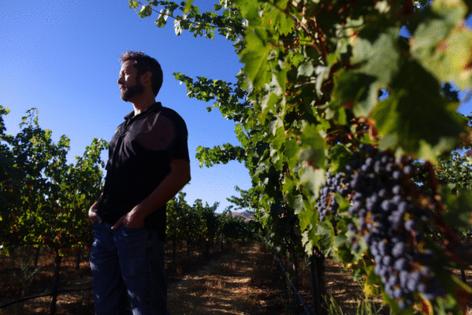Amid a weakened wine market, Alameda County grape growers nearly double the acreage of a classic varietal
Published in Business News
Beneath swaying cypress trees and Spanish tile roofs, winemakers at Las Positas Vineyards are preparing to harvest two of the fastest-growing grapes in Alameda County, California: cabernet sauvignon and cabernet franc.
These two Livermore Valley varietals are taking up more space in vineyards in recent years amid a contracting wine industry, as Livermore Valley emphasizes its heritage wines like cabernet sauvignon and looks to get in on a growing trend with cabernet franc, said Las Positas head winemaker Brent Amos.
“One nice thing about Livermore, we have the classic heritage varietals that just do extremely well,” Amos said. “And cab franc is really on the rise, both with customers and plantings in the valley. More and more growers are seeing the benefit of it.”
The number of acres for cabernet sauvignon has nearly doubled from 786 acres in 2017 to 1,369 acres in 2022, according to the most recent Alameda County Crop Reports available. The annual reports also show the explosive growth of cabernet franc, which has gone from 15 acres in 2017 to 60 acres in 2022.
Consumer demand for wine has softened since the end of the pandemic, with fewer direct sales and wine tastings at wineries for the second straight year, according to Silicon Valley Bank’s State of the Wine Industry Report 2024. Many Livermore wineries have not been profitable since 2018, according to a UC Davis and Tri-Valley Conservancy study. Consumers, it seems, have put down their wine glasses in favor of other spirits – hard seltzers, hard kombuchas, Mike’s hard lemonade – and made the alcohol industry more competitive than ever.
“All the wineries, we’re in this together, and we work together,” Amos said. “Technically, yes, we’re competitors, but at the same time, we’re working collaboratively to elevate this valley. Because if the valley succeeds, then we all succeed.”
An ‘old reliable varietal’
Cabernet sauvignon is not just the most popular wine for Livermore Valley winemakers, it’s the wine that started it all — especially for the Wente family.
Director of vineyard operations at Wente Vineyards Niki Wente, a fifth-generation winegrower, comes from the founding growers of Livermore Valley’s wine industry in 1883.
“Cabernet sauvignon has been a staple variety of the Livermore Valley since the 1880s, when Charles Wetmore brought cuttings to our region from France, including the bud wood that became known worldwide as the Concannon clone of cabernet sauvignon,” Wente said.
Today, nearly 80% of all California cabernet sauvignon crops are derived from Concannon clones, according to the Livermore Valley Winegrowers Association.
While Livermore Valley growers’ access to varietals has only grown since the 1880s, cabernet sauvignon remains its largest crop by far, with more acres dedicated to it than all red wine varietals combined.
It’s logical then for wine enthusiasts to seek more “cab sauvs” than other wines, Amos said, because the red wine varietal is the most popular on the market. A general understanding of cabernet sauvignon’s flavors and effects allows wine tasters to sense Livermore Valley’s unique mix of rich tannins and black cherry aromas.
“We’re all working together to be sure the valley is producing high-quality everything, but especially some of these more notable varietals, that customers have a benchmark for what it should taste like,” Amos said. “It’s definitely one of the old reliable varietals.”
Las Positas sets itself apart by not only aging its cabernet sauvignon in a barrel, but also fermenting it inside the barrel, which Amos said offers a more complex, well-balanced product.
With so much cabernet sauvignon being grown in Alameda County, it’s incumbent on winemakers to find methods that lead to unique, yet elegant bottles of red, said Brandi Lombardi, the executive director of the Livermore Valley Winegrowers Association. Methods like barrel fermenting keep heritage vines distinctive.
“What I love about Livermore Valley wine country is holding on to the traditions of our heritage varietals but still able to pivot to new innovations,” Lombardi said. “I think we have a look toward our history and eyes toward the future.”
Let’s be Franc
The latter is why winemakers like Amos are investing heavily in cabernet franc, a lighter-bodied French wine with more herbal flavors that’s acreage has quadrupled between 2017 and 2022, according to Alameda County crop reports.
“More and more customers are asking for something different,” Lombardi said. “They still want their classic varieties. They still want cab, they still want chardonnay, but they also want something else.”
While cabernet franc remains outside of the top five most popular grapes grown in Alameda County, winemakers are finding success with it and doubling down as a result.
“Many of the growers would like Livermore Valley to be known for cabernet franc, because it sets us apart from other regions like Napa, known for cabernet sauvignon, or Lodi, known for zinfandel,” Wente said. “Livermore wineries have caught on to how well it grows in the valley and the quality of wine that can be made from our fruit.”
Most white wine grapes were already harvested at Las Positas Vineyards when the East Bay Times visited Livermore Valley on Thursday, Sept. 5, Amos said. He walked between rows of vine-laden trellises and picked up fallen berries, predicting a high-quality yet lower-than-average yield harvest for 2024.
Cabernet sauvignon and cabernet franc grapes are still a month away from being picked, Amos said. Sugars in the fruit still need to condense before the fruit can be pressed, barrelled and stored away for a few years. But Amos is keen to offer another high-quality pouring of cabernet franc to unsuspecting customers.
“It’s one of those wines where you may not go to a winery seeking cab franc, but if they have a cab franc, chances are that’s the one you’re leaving with,” Amos said.
©#YR@ MediaNews Group, Inc. Visit at mercurynews.com. Distributed by Tribune Content Agency, LLC.












Comments